
Setting the house in order Mastering internal complexity
6 minute read
22 October 2019
To successfully implement digital procurement transformation, CPOs can't go at it alone. Partnerships with IT, finance, HR, and others are critical enablers to help the CPOs achieve their objectives.
Aligning various internal departments with procurement, with suppliers, with best practices, and even with each other is key to mastering internal complexity. Procurement is a nexus of complex processes and it wears many hats, serving as a partner, service provider, and a key member of strategic planning initiatives. Improving alignment in three key areas—functional, business, and digital—can help CPOs master internal complexity while raising their total value contribution. Yet for many procurement leaders, progress on these areas has been slow.
Learn more
Explore the survey
Download the full report or create a custom PDF
View the industry and regional survey results
Subscribe to receive related content from Deloitte Insights
Download the Deloitte Insights and Dow Jones app
View the overview webcast (live or replay)
Internal complexity begins with the need for procurement to maintain functional alignment, both as an enabling service provider for stakeholders and as a business partner in strategic planning. While only 26 percent CPOs surveyed described themselves as excellent internal business partners (figure 1) (the same as in the 2018 study), we dug deeper to understand how this relationship fared with “functional partners/peers” such as finance, IT, HR, and others who should be aligned with procurement to jointly serve the business units. CPOs reported that they have stronger relationships with some functions than others—namely, IT (50 percent), finance (46 percent), and operations (44 percent). These functions, they said, were most likely to rate procurement effectiveness as excellent (figure 2).
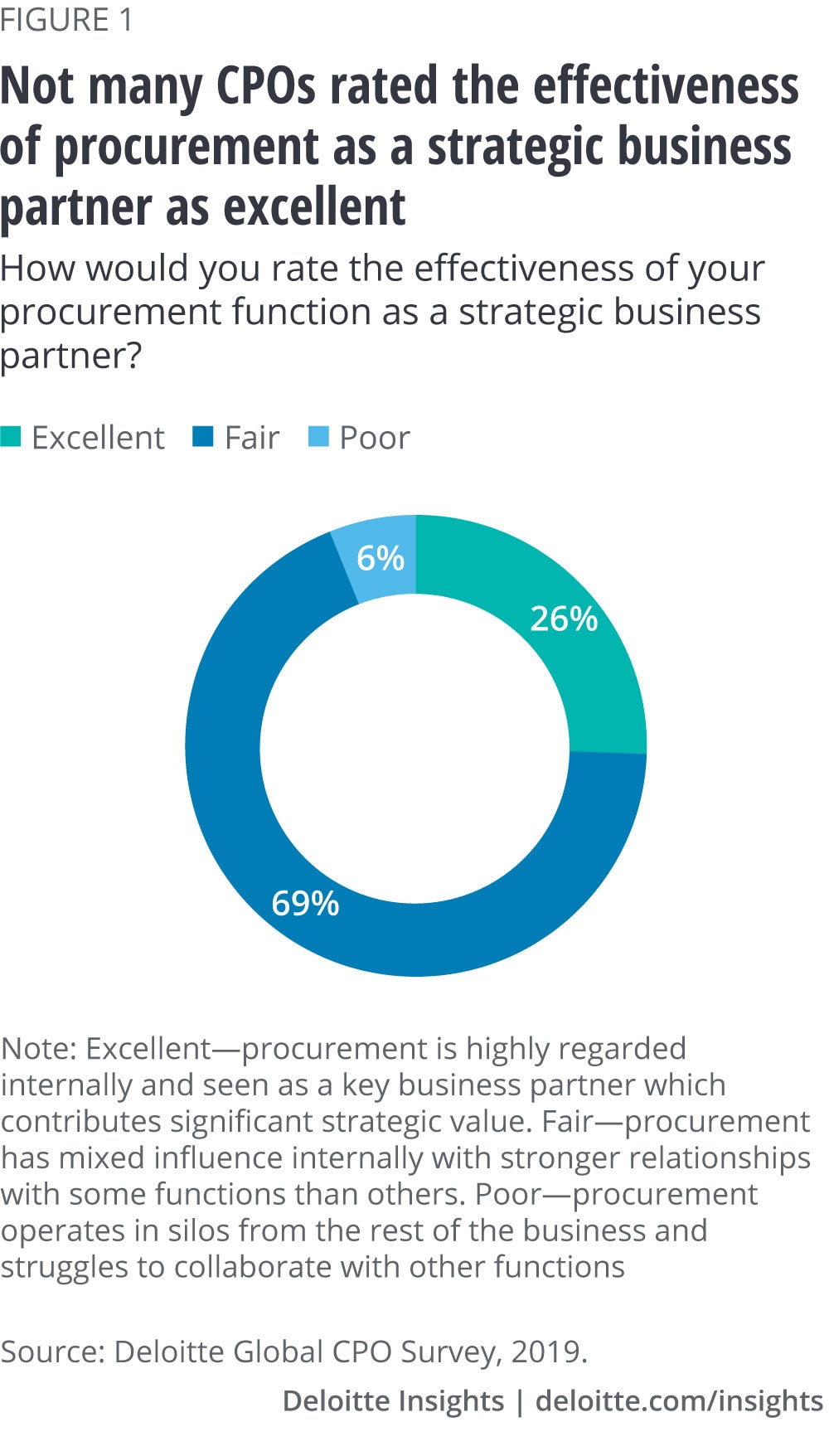
This presents challenges for procurement. Broader trends such as increased outsourcing of business functions and exploration of the external “gig” workforce suggest that a higher degree of collaboration will be needed between procurement and other functions to coordinate this externalized service delivery. Our 2018 global outsourcing survey, for example, indicates that when organizations were asked what they would do differently next time in launching an outsourcing initiative, four of the top five responses focused on how they would change their existing sourcing process to take a more structured approach.1 In fact, a sizable chunk of the respondents (42 percent) said that they should have spent more time in RFP or service provider selection.
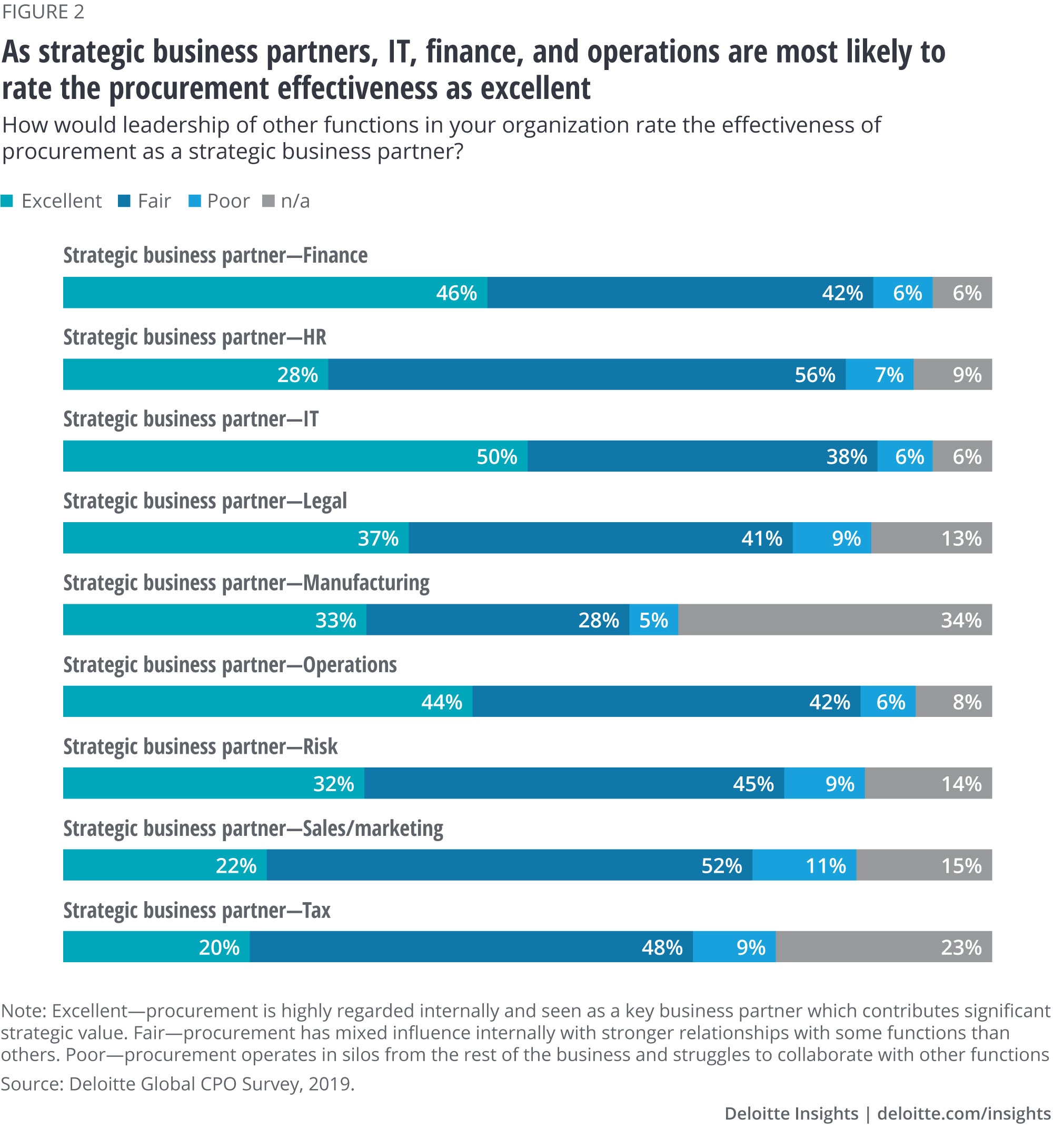
Developing an integrated approach for third-party management and end-to-end source-to-pay (S2P) is crucial for reducing internal complexity, but it also enables procurement to seek “good complexity” by adding more services to its own service portfolio and related strategies (figure 3). In other words, while spend consolidation (36 percent) is the top strategy, business partnering (27 percent) helps open the door to improving specifications, managing supplier relationships, and more.
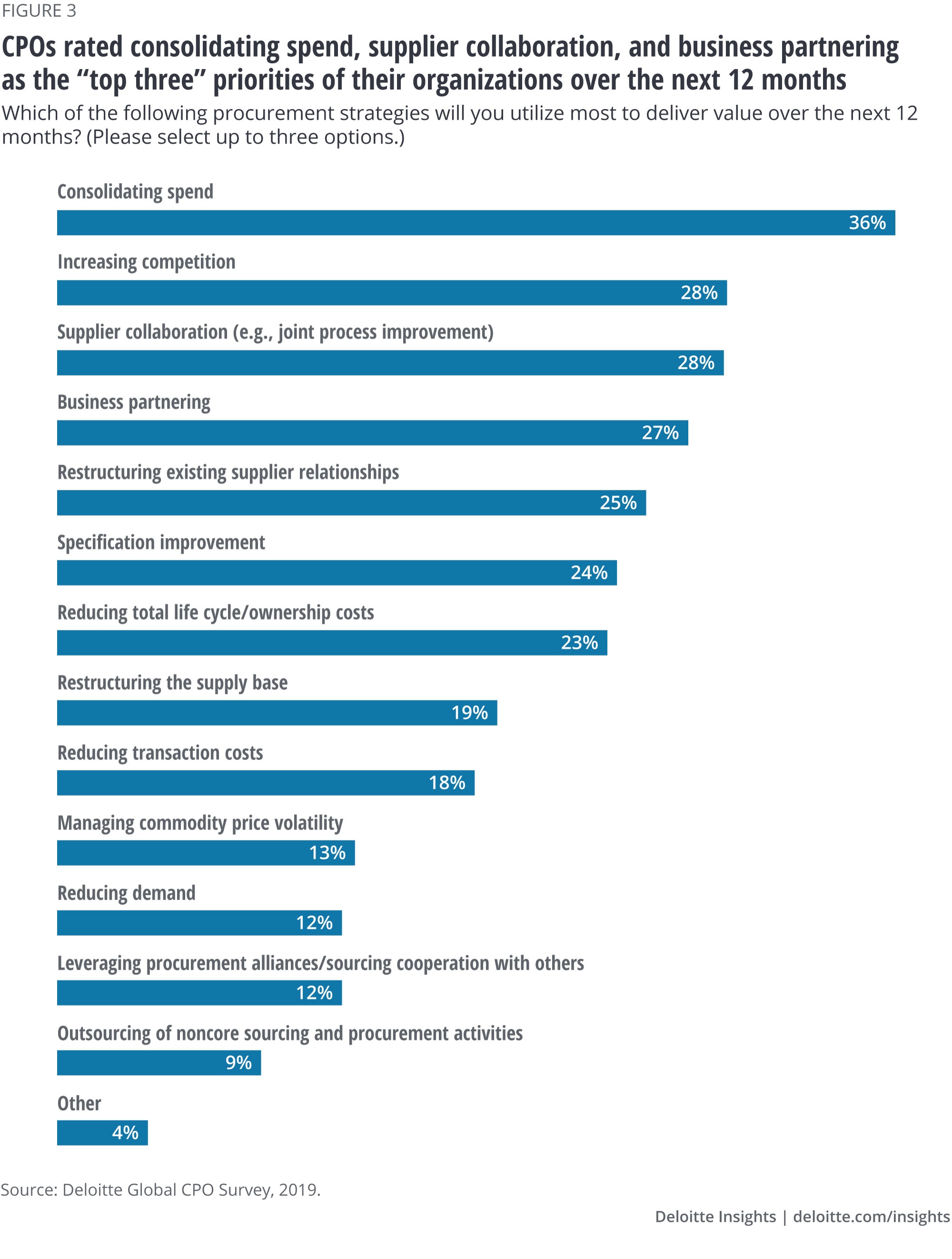
This snapshot shows an improving ability of procurement to align itself with key business goals but also a growing embrace of more advanced strategies beyond classic spend management, due to the requirements of changing supply markets (e.g., managing powerful “mega-suppliers” in turn requires a more robust relationship management approach) as well as the internal pressures for value creation that procurement is facing.
The aforementioned procurement strategies are best served up early in strategic decision-making processes (figure 4). This “quality of spend influence” is evidenced by procurement being always/usually involved in offshoring/outsourcing (61 percent), make-vs-buy (57 percent), and perhaps most importantly, financial forecasting/budgeting (56 percent) to influence the spending far upstream before it even occurs.
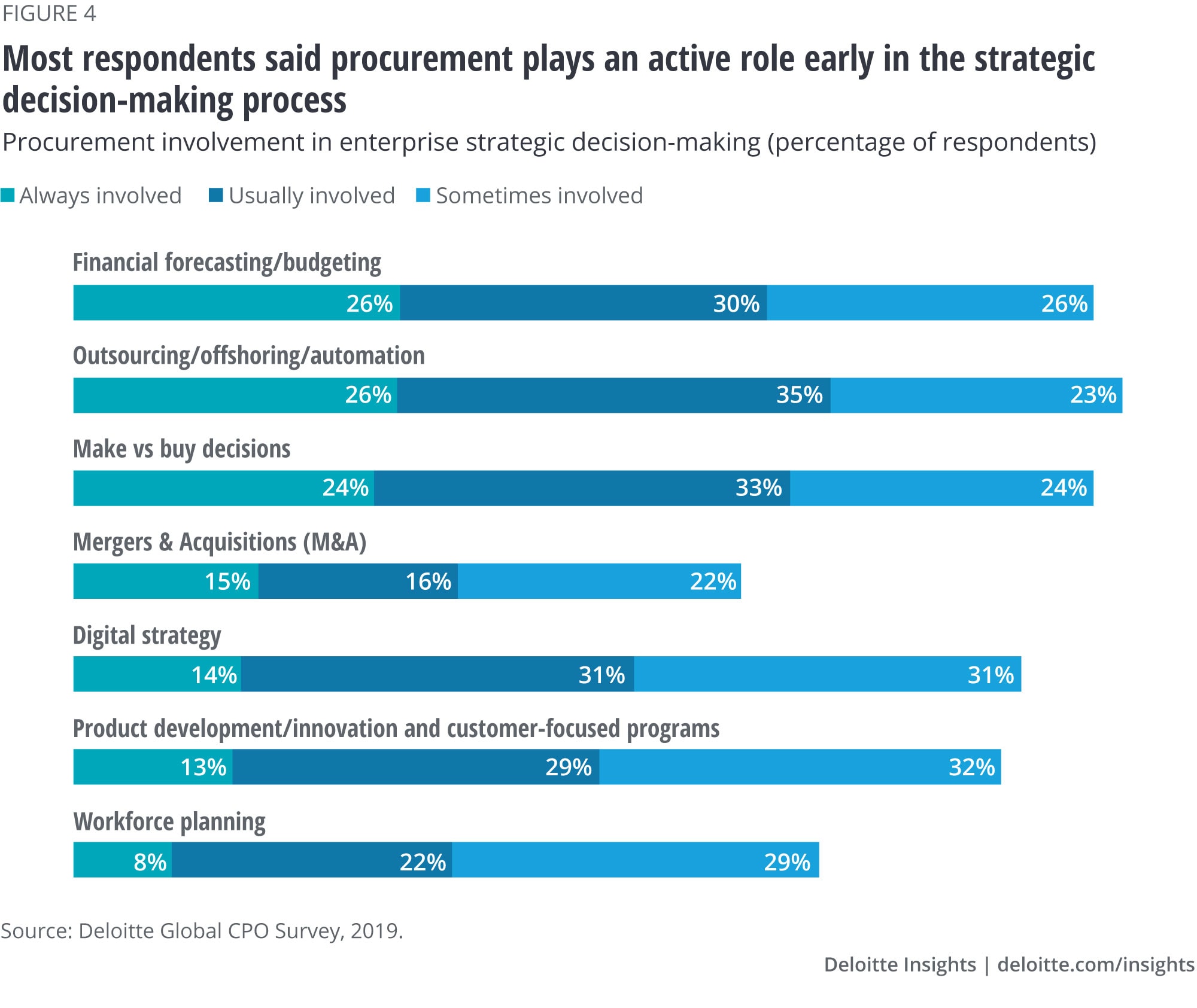
What should also be apparent, though, is the “digital disconnect” between procurement and the business, as evidenced by only 14 percent of procurement organizations always being involved (and 31 percent being usually involved) during enterprise-level digital strategy. This creates barriers to achieving true digital alignment.
“Business partnering has always been a priority on the agenda of Voith purchasing. However, in times of digital transformation its importance is set to increase as speed and agility are the new imperative. Purchasing needs to expand the ability to partner and collaborate with both internal and external stakeholders. Ultimately, purchasing has to position itself as an influential function to be in the inner circle of decision making, thereby driving competitiveness and innovation. We at Voith purchasing achieve this ambition through early involvement in the product development cycle and an integrated material group management process. Additionally, digital innovations such as robotics help us to shift capacities and capabilities from transactional tasks to seamless business partnering.”— Ralf Havermann, senior vice president & chief purchasing officer, Voith Group
Many of procurement’s value-creation priorities are dependent on digital capabilities, whether that be automation that allows resources to spend more time collaborating with suppliers (and tapping their digital capabilities) or utilizing analytics and third-party intelligence sources that can actually drive planning efforts rather than just reacting to them. However, it’s the business priorities that are most critical to align to, and while cost reduction and risk reduction are the top two cited priorities in today’s tumultuous times (figure 5), the next three strongest business priorities are focused on innovation and growth: expanding/introducing digital business models (52 percent), introducing new products/services or expanding into new markets (50 percent), and expanding organically (47 percent).
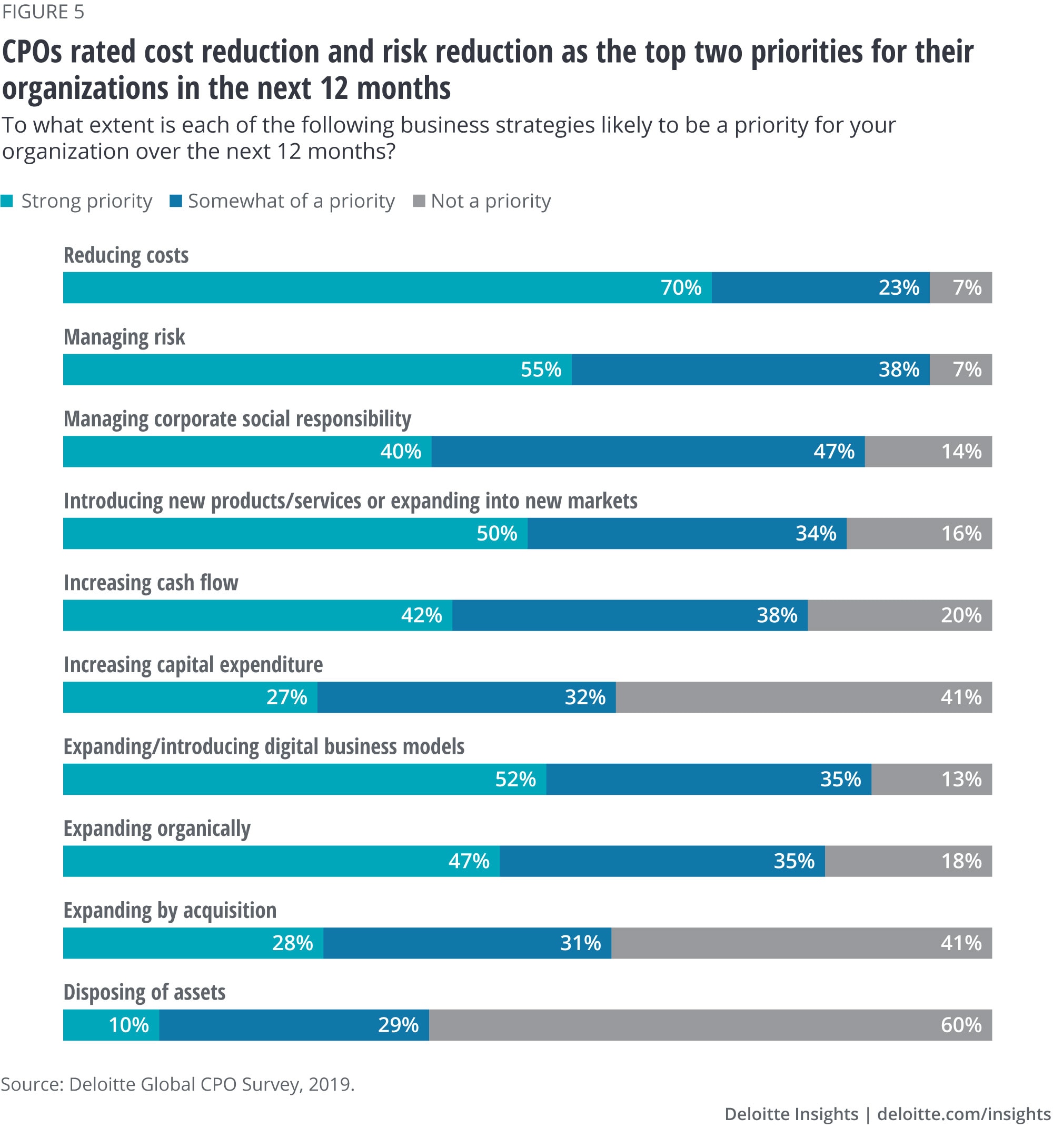
This disconnect creates a three-pronged imperative for procurement:
- Align early to digital business strategies and then tap suppliers’ digital innovations
- Gain strong IT alignment and IT sourcing capabilities to support agile development and optimization of commercial relationships
- Lead by example within procurement to develop digital capabilities that can be extended beyond procurement’s boundaries (e.g., market intelligence and predictive analytics)
This is easier said than done. Most procurement and IT organizations struggle with the digital complexity of managing the plethora of digital solutions available in the market and developed in house. Mastering this internal complexity effectively requires CPOs to align their objectives and values with other executives in their organizations. When planning for the coming year, complexity masters should look to first-principles to answer how their function can be best prepared to assist the business in achieving its goals.
So, what can CPOs do to help improve their mastery of the internal environment? Here are a few steps that they can take:
1. Determine the current maturity and influence levels in each alignment area. Before they set out to reduce the complexities of internal alignment, CPOs need to be clear about who their allies are and who may see the procurement function as an adversary. They need to make an effort to learn the language and unique characteristics of other functions’ supply chains, and apply those learnings in their appeal to C-level peers for procurement involvement. The goal should be to increase the amount of “good complexity” procurement is exposed to by broadening its service portfolio as it aligns to an increasing number of business priorities, ultimately allowing CPOs to proactively select the areas where procurement can add the most value and execute on shared priorities.
2. Coordinate your investments and activities to bridge gaps in your strategic alignment. For example, have you discovered that while your relationship with IT is strong, your procurement organization’s digital strategy is misaligned with IT’s road map? If so, you may need to begin a dialogue with the CIO to understand whether your strategy needs to shift, or whether there is information you can bring to IT to support a more holistic digital vision for your organization. Similar conversations should be held with other functions, especially adjacent ones such as engineering and production teams.
3. Go digital: Automating tactical processes to address complexity and make time for strategic alignment. Automation can help make life a little easier for procurement leaders. CPOs can turn to automation for tactical activities (e.g., tail spend purchasing, accounts payable processes) to enable a focus shift to strategic activities such as business partnering. Automating or accelerating aspects of the P2P cycle are an obvious starting point: Increasingly intelligent e-procurement systems are able to direct stakeholders to preferred sources of supply or even use predictive analytics to warn users of the (un)likelihood of a purchase request being approved.
© 2021. See Terms of Use for more information.
Read more
-
Building a cognitive digital supply network Article5 years ago
-
The rise of the digital supply network Article8 years ago
-
Synchronizing the digital supply network Article6 years ago
-
How blockchain enables the digital supply network Article6 years ago
-
The path to supply chain transparency Article10 years ago
-
The supply chain paradox Article6 years ago
















